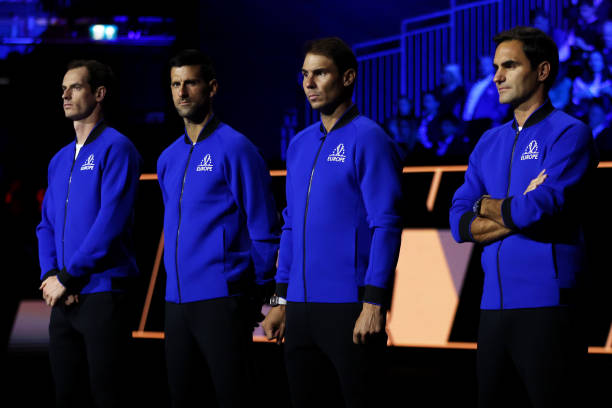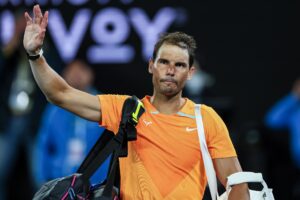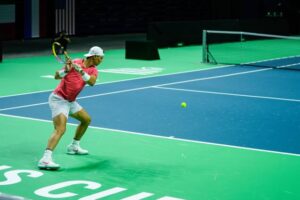In a new four-part series, Martin Keady, our resident tennis historian, considers the end of the great “Trivalry” between Federer, Nadal and Djokovic, which has come with Federer’s retirement, and argues that it was the greatest rivalry ever in any sport.
In all the understandable commemoration and celebration of the end of Roger Federer’s legendary career, it has been easy to overlook the fact that another great tennis institution has also come to an end: “The Trivalry”, or the remarkable three-way rivalry between Federer, Rafael Nadal and Novak Djokovic. For nearly 15 years (since Djokovic broke the existing Federer-Nadal duopoly by winning his first Slam in Melbourne in 2008), it has dominated men’s tennis, with only a few other men ever winning Majors in that time.
Now that Federer has finally departed the stage, it is time to assess that extraordinary tripartite or triangular rivalry and consider where it ranks not just in the history of tennis but in the history of all major professional sport. And any even-handed assessment would surely conclude that it is the greatest ever rivalry in sporting history.
The Trivalry
The Unique Nature of The Trivalry
Three may be a crowd in affairs of the heart, but in affairs of the court it virtually constitutes a tournament in its own right, at least when the three players concerned are the three greatest players in the history of men’s tennis, not just statistically but (especially in Federer’s case) stylistically. It is the very fact that three such all-time greats emerged at more or less exactly the same time and then proceeded to compete against each other for so long (over a decade and a half) at the highest level that makes The Trivalry so unique.
It was often said, by Mats Wilander and other great tennis players and analysts, that the reason it was so difficult for any other man to win a Major in the last 15 to 20 years is that they faced an unprecedented triple threat. Even if they could somehow beat one of The Big Three (as they came to be called, although The Gigantic Three would have been more accurate) at a Major, at least one, if not two of the others would almost certainly be lying in wait for them in a future round. And after the inevitably exhausting demands of beating one of The Big Three, there was often little left in the tank to face another one.
Wilander and other analysts who advanced this argument were, of course, right. However, what they often overlooked was the fact that The Big Three were not only an insuperable obstacle for other opponents but for each other, too. They did not always meet each other in Majors, but when they did the winner of any contest between two of them often meant that the victor was weakened, if only a little, by the experience and so were rendered more vulnerable than they might otherwise have been if they encountered the remaining member later on in the same tournament.
That was demonstrated perfectly at the last Major encounter of The Big Three, at Wimbledon in 2019, before the pandemic and the recurring injuries that led to Federer’s long retirement. Federer played fabulous tennis to defeat Rafael Nadal in the Wimbledon semi-final that year, but could not quite replicate that level against Djokovic in the Final. He still came mighty close, famously holding two match-points before losing in a truly historic fifth-set tie-break 7–6 (7–5), 1–6, 7–6 (7–4), 4–6, 13–12 (7–3). Consequently, given how close Federer came to beating Djokovic immediately after beating Nadal, it is surely arguable that if he had not encountered Nadal in the semi-final, he would have had enough energy and momentum left to have overcome Djokovic, too.
Unprecedented In the History of Tennis
That “The Trivalry” is the greatest ever rivalry in the history of tennis – not just men’s tennis, but men’s and women’s tennis – is surely axiomatic. The numbers alone prove that, in that all three members of The Big Three won at least 20 Majors, which puts all of them at least six Majors ahead of the next “winningest” man in tennis history, Pete Sampras. But even putting the numbers aside for a moment, it is surely unquestionable that there has never before been such a three-sided rivalry in the history of tennis.
Of course there have been great rivalries in tennis before. Sampras-Agassi, Graf-Seles, Edberg-Becker, Evert-Navratilova and, most obviously of all, Borg-McEnroe all have champions who proclaim the greatness of a particular rivalry, but they were all two-sided, not three-sided, affairs. The closest there has ever been to anything approaching The Trivalry in tennis before was the great triumvirate of Borg-McEnroe-Connors at the end of the 1970s and start of the 1980s.
However, even that did not last anywhere near as long as the rivalry between The Big Three, especially after Borg retired so young (just 25) in 1981. Also, with Borg dominating on both grass and clay but unable to translate that dominance to hard courts, it was never the all-surface battle that The Trivalry has been; even allowing for Nadal’s dominance of clay, which has exceeded even that of Borg, both Federer and Djokovic won the French Open (Djokovic twice), which was something that neither McEnroe nor Connors ever achieved.
But Also Unprecedented In The History of Sport
However, what is truly remarkable about The Trivalry is that it is not just unprecedented in the history of tennis but in the history of sport. And when I refer to “the history of sport”, I should make it clear that I am referring principally to the history of the major, professional global sports, such as football (soccer), cricket, basketball, tennis, golf, boxing and other “contact sports”, such as rugby, both union and league, and American football.
When I recently argued that Federer was the greatest artist in the history of sport, fans of more minor sports, such as gymnastics or ice-skating, rightly defended the artistry of their own particular favourite sport. However, such is the nature of those sports, which are invariably geared exclusively towards the major international events such as the Olympics rather than being self-sustaining major professional sports that are played week in and week out, that it is virtually impossible for even their greatest protagonists to have long careers and certainly not careers as long as those involved in the major professional global sports.
Olga Korbut, Dmitry Bilozerchev and Nathan Chen (to name just three of the greatest gymnasts and ice-skaters ever) all achieved remarkable and truly artistic triumphs, but their careers were all over by their mid-twenties. They certainly did not achieve the prolonged, indeed decades-long, success of those who have triumphed consistently in the major professional global sports, such as Federer, Nadal and Djokovic.
So, having made that clarification, it is surely self-evident that there has never been a three-sided rivalry comparable to that of Federer-Nadal-Djokovic in the history of the major professional global sports. Obviously, it is extremely difficult, if not impossible, to compare team sports, such as football or NFL, to an individual sport such as tennis. Nevertheless, setting aside the obvious differences between team sports and individual sports, it is impossible to find a three-way rivalry that lasted for 15 years in any major team sport, at either club or international level.
For example, the very greatest rivalries in the history of football, such as that between Real Madrid and Barcelona at club level or between Brazil and Italy at international level, may have lasted longer in absolute terms than The Trivalry in tennis (teams being able to regenerate themselves in a way that individuals cannot). However, they were precisely that – rivalries, not ‘trivalries’. Even when a third party has forced their way in, such as Atletico Madrid winning two La Liga titles in the last 10 years, they have still remained very much the junior party, or rival, rather than an equal third member .
The Greatest Trivalries In Sport Before Now
It is only in other individual major sports, in particular golf and boxing, that there have ever been three-sided rivalries approaching the great Trivalry of tennis, and even then they ultimately pale by comparison.
It is true that in golf there was a three-way fight for global domination between Arnold Palmer, Jack Nicklaus and Gary Player at the start of the 1960s, but it did not last for long (Palmer’s last golfing Major win coming in 1964). Moreover, only two of them (Nicklaus and Player) won every golfing Major, whereas all three of Federer, Nadal and Djokovic have achieved the Career Grand Slam of winning at least every tennis Major at least once.
Equally, in boxing the greatest three-way rivalry ever was undoubtedly that between Muhammad Ali, Joe Frazier and George Foreman in the early to mid 1970s. However, that golden age of heavyweight boxing was extremely short-lived in comparison with that of the recent golden age of tennis, because it was over within half a decade and the main protagonists only ever fought each other a few times at most. And before any boxing fan points out that boxing is a far more physically demanding sport than tennis (which it undoubtedly is), that still does not entirely account for the relative brevity of boxing’s great trivalry.
There Is Only One Contender To Rival The Trivalry
It is only in boxing’s other golden age, which came in the middleweight division rather than the heavyweight ranks, that a possible contender from another sport emerges to challenge the hegemony of The Trivalry in tennis. That is the 1980s, or the era of “The Four Kings”, as they were memorably christened by sports writer George Kimball in his definitive book of that name.
The four boxing monarchs in question were Sugar Ray Leonard, Marvin Hagler, Tommy Hearns and Roberto Duran. Undoubtedly, they are four all-time greats in their sport. Nevertheless, for all the brilliance of Kimball’s book (and it is one of the greatest books ever written about sport and not just boxing), its title is somewhat misleading, in that Duran’s hey-day was undoubtedly the 1970s. His own personal golden age effectively ended in 1980, with his win over Leonard in their first bout. The great Panamanian never again defeated another one of the foursome despite several bouts against them.
Consequently, even allowing for the apparently greater numerical supremacy of “The Four Kings” era in boxing, The Trivalry in tennis remains unparalleled in any other major professional sport. That is why when the time comes for the definitive account of the careers of Federer, Nadal and Djokovic to be written, which can obviously only happen after all three have retired, it will surely pay homage to Kimball’s memorable title and be called “Three Gods”. Given their unprecedented dominance of tennis for over 15 years, Federer, Nadal and Djokovic are all undoubtedly deserving of the status of sporting deities.
Next time: Obviously, not all three members of The Trivalry could get on court in singles at the same time, so next time Martin will begin breaking down The Trivalry into its constituent parts, beginning with the great rivalry between Federer and Nadal.
Main photo:
Embed from Getty Images





